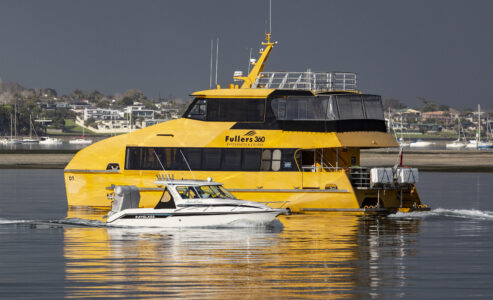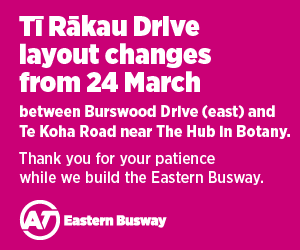
Auckland Transport’s (AT) first new electric ferries will be powered by locally-generated electricity, helping to reduce fuel consumption by 1.5 million litres annually and carbon dioxide emissions by 4,000 metric tons annually.
The agency says ferries represent 20 per cent of the city’s public transport emissions but carry only six per cent of passengers.
Auckland’s ferries currently burn up to 13 million litres of diesel per year, generating the equivalent of 34,000 tonnes of carbon dioxide tailpipe emissions.
Each new electric ferry will improve reliability, network resilience and service capabilities, with increased frequency and more sailings on key routes.
AT says it’s taken customer feedback on board to develop modern, functional layouts and interiors.
The new ferries will have increased passenger capacity, improved accessibility for boarding, debarking and moving around the vessel, and 24 to 28 spaces for prams, bicycles and scooters, depending on vessel layout.
Two fast ferries that will run at a speed of 23-25 knots are being built at the McMullen and Wing shipyard in Mount Wellington.
Designed by EV Maritime, they feature HamiltonJet propulsion technology and are intended for short inner-harbour and longer mid-harbour routes.
“Each vessel can carry 200 passengers and includes covered storage for up to 24 bikes,” AT says.
“To offset the weight of batteries and other electrical systems on board, the ferries are made from carbon-fibre composite, which is much lighter than aluminium.
“Lighter vessels can operate with greater efficiency and range, as composite hulls displace less water and last longer.
“The first ferry is expected to launch in late 2024. Passenger services should begin in mid-2025, once vessel commissioning, sea trials, certifications and crew training are complete.”
Two 32-metre electric-hybrid passenger vessels are being built at the Q-West boatbuilding yard in Whanganui.
They feature HamiltonJet propulsion, energy storage systems and electrical integration.
Fullers360 is involved in managing the build on behalf of AT and will operate the ferries.
They’re designed by Australian naval architects Incat Crowther.
Each vessel can carry 300 passengers and includes covered storage for up to 24 bikes.
The hybrid ferries will primarily service the Devonport to Downtown route.
The first is expected to arrive in early 2025 and the second in early 2026.
Passenger services will begin once vessel commissioning, sea trials, certifications and crew training are complete.
Some ferry terminal pontoons will be upgraded to accommodate the new larger ferries, and new charging facilities will be built at Half Moon Bay, Downtown Ferry Terminal and Hobsonville Point.
AT will install charging infrastructure using a staged approach, starting at Half Moon Bay in late 2024.
“Building equipment will convert AC power from the local substation into DC power to charge the ferries, similar to how batteries in phones and laptops charge, but on a much bigger scale,” the agency says.
“Underground electrical cables will run between the charger building and a charging point on the pontoon where the ferry docks.
“Plugs there will connect to the ferry to charge it while passengers are getting on and off.
“The charging speed will be approximately 10 times that of a high-speed car charger.”










